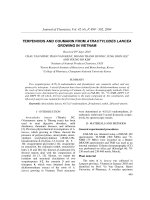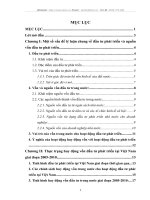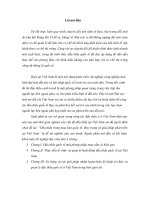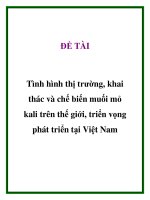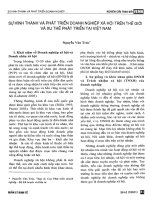Terpenoids và coumarin từ Atractylodes lancea phát triển tại Việt Nam
Bạn đang xem bản rút gọn của tài liệu. Xem và tải ngay bản đầy đủ của tài liệu tại đây (101.96 KB, 4 trang )
499
Journal of Chemistry, Vol. 42 (4), P. 499 - 502, 2004
Terpenoids and coumarin from Atractylodes lancea
growing in Vietnam
Received 29
t
h
-Sept.-2003
Chau Van Minh
1
, Phan Van Kiem
1
, Hoang Thanh Huong
1
, Jung Joon Lee
2
and Young Ho Kim
3
1
Institute of Natural Products Chemistry, VAST
2
Korea Research Institute of Bioscience and Biotechnology, Korea
3
College of Pharmacy, Chungnam National University Korea
Summary
Two sesquiterpenes 4(15),11-eudesmadiene and
-eudesmol, one coumarin osthol, and one
pentacyclic triterpene 3-acetyl-
-amyrin have been isolated from the dichloromethane extract of
the roots of Atractylodes lancea growing in Vietnam, by various chromatography methods. Their
structures were determined by spectroscopic means such as FAB-MS,
1
H-,
13
C-NMR, DEPT 135
and DEPT 90. Of which, 4(15),11-eudesmadiene is the main compound of the constituents, and
3
-acetyl-amyrin was isolated for the first time from Atractylodes lancea.
Keywords: Atractylodes lancea, 4(15),11-eudesmadiene,
-eudesmol, osthol, 3
-acetyl-amyrin.
I - Introduction
Atractylodes lancea (Thunb.) DC.
(Vietnamese name is Thuong truat) has been
used to treat digestive disorders, mild
diarrhorea, rheumatic diseases, and influenza
[2]. Previous phytochemical investigations of A.
lancea, which growing in China, showed the
presence of polyacetylenes, atractylodin, atract-
ylodinol, acetylatractylodinol, (4E,6E,12E)-
tetradecatriene-8,10-diyne-1,3,14-triol [6, 8 -
10]; sesquiterpene-glycosides [14]; sesquiterpe-
ne atractylon, the coumarin osthol, atractyleno-
lides I, II and III [12]; hinesol, -eudesmol [8].
Several reports deal with the composition of
essential oil [3, 15]. Herein, we report the
isolation and structural elucidation of two
sesquiterpenes 1-2, the cumarin 3 and one
triterpene 4, which were obtained from the
dichloromethane extract of the roots of A.
lancea growing in Vietnam. Their structures
were determined as 4(15),11-eudesmadiene, -
eudesmol, osthol and 3-acetyl--amyrin, respec-
tively, by spectroscopic means.
II- MATERIALS AND METHODS
General experimental procedures
FAB-MS was obtained using a JMS-SX 102
spectrometer.
1
H-NMR (300 MHz) and
13
C-
NMR (75 MHz) were recorded on a Bruker
DRX300 spectrometer and TMS was used as an
internal standard. Column chromatography (CC)
was performed on silica gel (Kieselgel 60, 70-
230 mesh and 230-400 mesh, Merck).
Plant material
The roots of A. lancea was collected in
Langson province, Vietnam in January 2003 and
identified by Prof. Vu Van Chuyen, Hanoi
University of Pharmacy. A voucher specimen
500
was deposited at the herbarium of the Institute of Natural Product Chemistry, VAST, Vietnam.
H
1
2
3
4
6
5
7
8
9
10
11
12
13
14
15
1
OHH
1
2
3
4
6
5
7
8
9
10
11
12
1
3
14
15
2
OOH
3
CO
2
3
4
5
6
7
8
9
10
1'
2'
3'
4'
5'
3
H
3
C-C-O
1
3
17
29
30
10
O
4
Fig. 1: Structurtes of 1, 2, 3 and 4
Extraction and isolation
The dried and powdered roots of A. lancea
(680 g) were extracted repeatedly with hot
MeOH three times. The combined solutions
were evaporated under reduced pressure to give
MeOH extract (45.0 g), which was suspended in
water and then partitioned with dichlorome-
thane. The dichloromethane fraction (32.0 g)
was then chromatographed on a silica gel
column, using hexane-acetone (from 100 : 1 to
5 : 1) as the eluent yielded five fractions (AL.1-
AL.5). Fraction AL.1 was then chromatogra-
phed on a silica gel column, using hexane-
ethylacetate (100:1) as the eluent yielded 1 (1.2
g) and 2 (28.0 mg) as white oils. Fraction AL.3
was then chromatographed on a silica gel
column, using hexane-ethylacetate (100 : 2) as
the eluent yielded 3 (12.0 mg) and 4 (15.0 mg)
as white crystals.
4(15),11-Eudesmadien (1): A white oil, FAB-
MS m/z: 205 [M+H]
+
(positive);
1
H-NMR
(CDCl
3
) (300 MHz) : 4.75 (2H, br s, H
2
-12),
4.74 (1H, s, H
a
-15), 4.55 (1H, s, H
b
-15), 1.82
(3H, s, H
3
-13) and 0.78 (3H, s, H
3
-14).
13
C-
NMR (CDCl
3
) (75 MHz) : 152.2 (s, C-11),
151.4 (s, C-4), 108.6 (t, C-12), 105.7 (t, C-15),
50.3 (d, C-5), 46.3 (d, C-7), 42.4 (t, C-1), 41.6
(t, C-3), 37.3 (t, C-9), 36.6 (s, C-10), 29.9 (t, C-
6), 27.2 (t, C-2), 23.9 (t, C-8), 21.4 (q, C-13)
and 16.7 (q, C-14).
-Eudesmen-11-ol (2): A white oil, FAB-MS
m/z: 223 [M+H]
+
(positive);
1
H-NMR (CDCl
3
)
(300 MHz) : 4.75 (1H, s, H
a
-15), 4.55 (1H, s,
H
b
-15), 1.25 (6H, s, H
3
-12, 13) and 0.71 (3H, s,
H
3
-14).
13
C-NMR (CDCl
3
) (75 MHz) : 151.5
(s, C-4), 105.7 (t, C-15), 74.0 (s, C-11), 50.2 (d,
C-5), 49.9 (d, C-7), 42.2 (t, C-1), 41.6 (t, C-3),
36.7 (t, C-9), 36.6 (s, C-10), 27.5 (q, C-12, 13),
25.4 (t, C-2), 23.9 (t, C-6), 22.7 (t, C-8) and
16.7 (q, C-14).
Osthol (3): White crystals, m.p 82 - 83
o
C; FAB-
MS m/z: 241 [M+H]
+
(positive);
1
H-NMR
(CDCl3) (300 MHz) : 7.61 (1H, d, 9.6 Hz, H-
4), 7.29 (1H, d, 8.4 Hz, H-5), 6.84 (1H, d, 8.4
Hz, H-6), 6.23 (1H, d, 9.6 Hz, H-3), 5.24 (t, 7.2,
Hz, H-2’), 3.93 (3H, s, C7-OCH
3
); 3.54 (2H, d,
7.2 Hz, H-1’) 1.85 (3H, s, H-4’) and 1.68 (3H,
s, H-5’).
13
C-NMR (CDCl
3
) (75 MHz) : 161.7
(s, C-2), 160.6 (s, C-7), 153.2 (s, C-9), 144.1
(d, C-4), 133.0 (s, C-3’), 126.6 (d, C-5), 121.6
(d, C-2’), 118.4 (s, C-8), 113.4 (d, C-3), 113.3 (s,
C-10), 107.8 (d, C-6), 56.4 (q, C7-OC
H
3
), 26.2
(q, C-5’), 22.3 (t, C-1’) and 13.8 (q, C-4’).
3-acetyl-amyrin (4): White crystals, m.p 241 -
501
242
o
C; FAB-MS m/z: 469 [M+H]
+
(positive);
1
H-NMR (300 MHz) : 5.21 (1H, t, 3.5, H-12),
4.54 (1H, dd, 6.0, 2.1, H-3), 2.07 (3H, s,
COCH
3
), 1.14 (3H, s, H
3
-27), 0.98 (6H, s, H
3
-
26, 25), 0.88 (12H, s, H
3
-30, 29, 24, 23) and
0.84 (3H, s, H
3
-28).
13
C-NMR (CDCl
3
) (75
MHz) : 171.4 (s, CH
3
CO), 145.6 (s, C-13),
122.1 (d, C-12), 81.3 (d, C-3), 55.7 (d, C-5),
48.0 (d, C-18), 47.7 (d, C-9), 47.2 (t, C-19),
42.1 (s, C-14), 40.2 (s, C-8), 38.7 (t, C-1), 38.1
(s, C-4), 37.5 (t, C-22), 37.3 (s, C-10), 35.1 (t,
C-21), 33.7 (q, C-29), 33.0 (t, C-7), 32.9 (s, C-
17), 31.5 (s, C-20), 28.8 (q, C-23), 28.4 (q, C-
28), 27.3 (t, C-2), 26.6 (t, C-15), 26.3 (q, C-27),
24.1 (q, C-30), 24.0 (t, C-16), 23.9 (t, C-11),
21.7 (q, C
H
3
CO), 18.7 (t, C-6), 17.2 (q, C-26),
17.1 (q, C-25) and 15.9 (q, C-24).
Iii - Results and discussion
Repeated column chromatography on silica
gel of the dichloromethane extract of the dried
roots of A. lancea yielded 1-4 (see experimental
part). Compounds 1 and 2 were yielded as white
oils. Compound 3 and 4 formed as white
crystals.
The positive FAB-MS spectrum of 1 showed
the molecular ion at m/z 205 [M+H]
+
,
corresponded to the formula of C
15
H
24
. The
1
H-
and
13
C-NMR spectra of 1 confirmed the
presence of 15 carbons, including two >C=CH
2
groups {
H
4.75 (2H, br s, H
2
-12), 4.74 (1H, s,
H
a
-15), 4.55 (1H, s, H
b
-15);
C
152.2 (s, C-11),
108.6 (t, C-12), 151.4 (s, C-4), 105.7 (t, C-15)};
Two tertiary methyl groups {
H
1.82 (3H, s, H
3
-
13) and 0.78 (3H, s, H
3
-14);
C
21.4 (q, C-13),
16.7 (q, C-14)}. The spectral data of 1 were in
good agreement with those of reported data of
4(15),11-eudesmadiene [11], thus 1 was
identified to be 4(15),11-eudesmadiene, a
sesquiterpene.
Compound 2 showed the molecular ion at
m/z 223 [M+H]
+
, in the positive FAB-MS
spectrum, which corresponded to the formula of
C
15
H
26
O. The
1
H- and
13
C-NMR spectra of 2
also revealed 15 carbons of a sesquiterpene,
including one >C=CH
2
group {
H
4.75 (1H, s,
H
a
-15) and 4.55 (1H, s, H
b
-15);
C
151.5 (s, C-4)
and 105.7 (t, C-15)}; three tertiary methyl
groups {
H
1.25 (6H, s, H
3
-12, 13), 0.71 (3H, s,
H
3
-14);
C
27.5 (q, C-12, 13), 16.7 (q, C-14)}, a
oxygene bearing tertiary carbon (74.0, s, C-11).
The structure of 2 was determined to be 4(15),
11-eudesmen-11-ol (-eudesmol) by comparison
the spectral data of 2 with those of 1 and of the
reported data [7, 11].
Compound 3 showed the molecular ion at
m/z 245 [M+H]
+
in the positive FAB-MS
spectrum, which corresponded to the formula of
C
15
H
16
O
3
. The
1
H- and
1
3
C-NMR spectral signals
of 2 almost assignable to those of a coumarin
including one methoxy group {
H
3.93 (3H, s,
7-OCH
3
);
C
56.4 (q, 7-OCH
3
)}; two tertiary
methyl groups {
H
1.85 (3H, s, H-4’) and 1.68
(3H, s, H-5’);
C
13.8 (q, C-4’), 26.2 (q, C-5’)}.
The spectral data of 3 matched well with those
of osthol in the reported data [5], thus 3 was
identified as osthol.
The positive FAB-MS spectrum of 4 showed
the molecular ion at m/z 469 [M+H]
+
,
corresponded to the formula of C
32
H
52
O
2
. The
MS and NMR spectra confirmed that 4 was a
pentacyclic-triterpene, which had eight methyl
groups {
H
1.14 (3H, s, H
3
-27), 0.98 (6H, s, H
3
-
26, 25), 0.88 (12H, s, H
3
-30, 29, 24, 23), and
0.84 (3H, s, H
3
-28);
C
33.7, 28.8, 28.4, 26.3,
24.1,17.2, 17.1, 15.9}; a trisubstituted double
bond {
H
5.21 (1H, t, 3.5, H-12);
C
145.6 (s, C-
13), 122.1 (d, C-12)}, and an acetoxy group {
H
2.07 (3H, s, COCH
3
);
C
21.7 (q, CH
3
CO), 171.4
(s, CH
3
CO)} at axial configuration {4.54 (1H,
dd, J = 6.0, 2.1, H-3)} [1,13]. Based on above
data and comparison with the reported data
[1,13], compound 4 was identified to be 3-
acetyl-amyrin.
This is first report of 4 from Atractylodes
lancea.
Acknowledgements: This study was supported
by a grant from the Korea-Vietnam cooperation
project. We are grateful to the KBSI for
measuring the MS and NMR spectra. We thank
to Prof. Vu Van Chuyen, Hanoi University of
Pharmacy for the plant identification.
502
References
1. U. V. Ahmad and A. Rahman. Handbook of
Natural Products data, 2, 163-1164, Amster-
dam-London-New York-Tokyo, Academic
Press (1994).
2. V. V. Chi (ed.). Vietnamese Medical Plant
Dictionary, Hanoi Medicine Pub. (1997).
3. K. Bruns, H. Dolhaine and U. Weber, World
crops: Productions, Utilization and
Description, 7, 207 (1982).
4. N. X. Dung, T. D. Chinh, D. D. Rang, P. A.
Lectercq. J. of Essential Oil Research, Vol.
6, No. 6, 637 - 638 (1994).
5. T. Fujioka, K. Furumi, H. Fujii, H. Okabe,
K. Mihashi, Y. Nakano, H. Matsunaga, M.
Katano, and M. Mori, Chem. Pharm. Bull.,
Vol. 47, No. 1, P. 96 - 100 (1999).
6. M. S. Lehner, A. Steigel, and R. Bauer,
Phytochemistry, 46, P. 1023 - 1028 (1997).
7. Y. Naya et al. Tetrahedron letters, 23, 3047
(1982).
8. Y. Nakai, T. Kido, K. Hashimoto, Y. Kase, I.
Sakakibara, M. Higuchi, and H. Sasaki. J. of
Ethnopharmacology, 84, 51 - 55 (2003).
9. Y. Nishikawa, I. Yasuda, Y. Watanabe, and
T. Seto, Yagugaku Zasshi, 96, 1322 (1976).
10. Y. Nishikawa, I. Yasuda, Y. Watanabe, and
T. Seto, Shoyakugaku Zasshi, 30, 132
(1976).
11. R. Phila, J. P. Bianchni, A. R. P.
Ramanoelina, J. R. E. Rasoarahona, R.
Faure, A. Cambon, Phytochemistry, Vol. 47,
No. 6, P. 1085 - 1088 (1998).
12. M. Resch, A. Steigel, Z. Chen, and R.
Bauer, J. Nat. Prod. 61, 347-350 (1998).
13. M. Shunyo, T. Reiko, and A. Masao,
Phytochemistry, 27, 535-537 (1988).
14. S. Yahara, T. Higashi, K. Iwaki, T. Nohara,
N. Marubayashi et al, Chem. Pharm. Bull,
37, 2995-3000 (1989).
15. Yosioka, T. Nishino, and I. Kitagawa,
Yagugaku Zasshi, 96, 1229 (1976).
